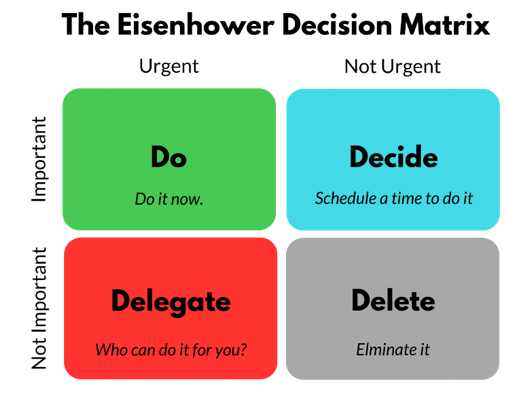Setting priorities
“If you want to use of your time well, you have to know what’s most important and then put all your effort into it.”
(Lee Iacocca, former Chairman of the Board of Chrysler Corp.)
You may know this: The workday begins, countless tasks are piling up and there’s not enough time to get them done. Doing everything at once would be simply impossible. But you have no choice: You have to tackle the work somehow. How do you go about it? How do you decide what is really important?
Setting priorities is the essence of time management. Priorities clarify things and let you navigate through the clutter of daily tasks. But how do you determine what should really take priority? In order to arrange tasks based on their importance, the first step is to identify the priority.
This may seem easy. People often set priorities based on the urgency of the issue, such as the deadline for a paper or an exam date. If such a clear specification is missing or unexpected tasks are added, the risk of losing sight of what’s essential and of getting bogged down increases.
This makes it all the more important to ask yourself what really has priority. This question is not always easy to answer because priorities are always linked to your personal goals. Therefore, if you want to set your priorities correctly, you first have to find out what you want to accomplish. Especially with long-term goals, it is necessary to know exactly where you want to go.
→ Always ask yourself before you start: What are my goals – and how will I reach them? What’s important here? By when do I want to have achieved what?
Once you’ve set a specific goals or milestone, there are several methods to help you prioritise. Here are three examples:
The ‘SMART’ Method
Defining goals clearly can be challenging. Often, plans are formulated so vaguely that they cannot be reached at all. The SMART method helps to clearly define goals and make them measurable.
SMART stands for:
- Specific: A goal should be formulated as precisely as possible.
- Measurable: The achievement of the goal should be objectively verifiable (who/what/when/how much/how often)?
- Attractive: The goal should be accepted by everyone involved.
- Realistic: The goal should always be achievable for everyone involved.
- Time-bound: The goal should be reached within a fixed period.
SMART:
The ‘Pareto’ principle
Once you have set yourself a goal, it’s important to plan how you will reach it efficiently. The Pareto principle can help you turn priorities into concrete actions. What is this principle all about?
A typical distribution pattern shows that about 80% of the results are due to 20% of the effort. This principle can also be applied to how we spend our time and achieve results: It states that 80% of the tasks can be completed in 20% of our time. Conversely, 80 percent of the time is required for the remaining 20 percent.

To use your time profitably, we recommend the following:
- Make a to-do list
- Enter in it the time required and the importance of each task
- In the morning, start by addressing the priorities
- Do smaller tasks first that are really urgent. This will give you the feeling of having accomplished quite a bit!
- Then devote yourself to the larger tasks that are also urgent.
- Be strategic with tedious and/or difficult tasks: Focus on the essentials first and do the additional tasks only if time allows you to do so.
- Forget about always having to do everything perfectly.
- Don’t waste time on inconsequential details.
- Learn to set healthy boundaries and say “no.”
The ‘Eisenhower’ Principle
The Eisenhower Principle is about managing your time well and completing your tasks as planned. You can do this by separating the important from the unimportant and then setting your priorities. The term goes back to a speech in which the American President Dwight D. Eisenhower quoted a university president in 1954 with the following words: “I have two kinds of problems, urgent ones and important ones. The urgent ones are not important, and the important are never urgent.”

Using the Eisenhower Matrix:
Try out and discuss:
- Setting priorities (Exercise Priorities)
- The Pareto principle (Exercise Pareto)
- How important has it been for you to identify your priorities and act on them?
- Do you find it difficult to set priorities? If so, why?
Cover picture: “task” by Mada Creative from the Noun Project
